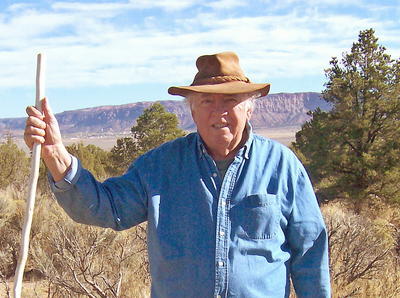|
N6LRG Ralph D. 'Mac' Magee Fredonia, AZ QCWA # 38348 |
 |
I don't like "Ralph" so please call me "Mac". My earliest experience with radio, was as a kid, as I laid on the floor, looking up at a towering, Zenith radio, bristling with buttons, knobs and a large, glowing, soft yellow dial, listening to "The Shadow", "Sky King", "The Green Hornet", "The Lone Ranger" and other wonderful heros of yesteryear. Of course, I ordered someone's "Secret Ring", and waited to meet the mailman outside every day 'till it arrived! (A boxtop or two, from Wheaties and .25 cents was all it took.)
After high school graduation in '57 and 2 years of Navy Reserve service prior, I went into the active Navy for the next 8 years. After about 6 months on the deck force, I worked my way into the radio gang and up to RM1, (Radioman 1st class, E6) Also passed proficiency pay tests to the 2nd level, highest available at the time. (Gave me more bucks :) I received a certificate for bug operations, (Known as the "speed key" in the Navy.) It was required that you have the certificate or you couldn't use the bug. The test was send/recieve, 30 wpm, for 5 minutes, with 2 errors allowed, but I didn't make any. :) Served aboard two ships, the USS Weeden DE797, and the USS Theodore E. Chandler, DD717 for 3 years. (By the way, I only had occasion to use the bug once...a 900 group coded message thru San Francisco, NPG. (He was a Good Operator, got it all; no repeats!)
Next, I was transferred to London, England, (CINCUSNAVEUR/CINCNELM/NAVSUPACTS LONDON - The admiral wore 3 hats) Did 3 years in London, and I was awarded a Navy Letter of Commendation, for creating a cryptographic course with which I trained two officers and 5 enlisted men. I also wrote "Kryptos Logos", (Hidden Discourse) a brief cryptographic history, including some simple, workable, cryptographic devices.
Then; San Diego, and shore duty again,(COMNAVAIRPAC) for 2 years. After this, I left the Navy in '65, and eventually got WN6MQE, WN6MLJ, and KA6IMO. I ended up with N6LRG in '89 (FINALLY...General class!) My first license in Nevada, was KN7HWR. My first transmitter a two-tube, Ameco AC1 kit, CW rig for 40 and 80. 15 mighty watts and I worked 36 states with it! The receiver was a Radio Shack general coverage, with bandspread. (Still have 'em.)
Vel and I live in Cane Beds, Arizona, on our "Happy Endings Ranch". There's no local address, 'cause this isn't a city or town, just a "place." The address you see through this service, is a mailing address only, 35 miles from me. Since I don't live in Fredonia, Arizona, and if you're a county hunter, put me in Mohave County.
Find me on 7.228, 7.272, 145.490, 146.910, 146.820, 449.325 or 146.800. (All local S. Utah, N. Arizona repeaters. I sometimes check into these nets: Western Shriner's, RV Service Net, Tin Can Sailors Net, the Noon Time Net, and the High Noon Net and Jefferson Noon Net.
I'm "emergency-oriented", and like to have all available communications aboard. In the past, as the Newbury Park Stake Emergency Communications Coordinator, I organized a fully-equipped, emergency communications system, outfitting 3 facilities with equipment and operators. I provided training and enlistment. It was the LDS church in Newbury Park, California. We entered and won, the first MARA World-Wide field day, 24 hour operation, using only emergency power. We made the most LDS contacts in Canada, Mexico, New Zealand, Japan and the U.S. and gained bonus points for physical delivery of received messages, directly to ward and stake leaders via radio-dispatched vehicles. Our communications center became a "show place" for other stakes and operators.
CURRENT STATION EQUIPMENT:
2 rigs for VHF and UHF; Yaesu FT2800M (2m), Alinco rig for 440 (mobile types), Also use an 11 meter rig with A99 vertical antenna which can also be used on 17 and 20m. 16 states so far on low power.Base HF radio is the IC718. (As of 10-12-11) with Heil desk mic.
Mobile rig is a Yaesu FT857D. This uses a screwdriver antenna, the Little Tarheel II (6 to 75m). The VHF/UHF antenna is an MFJ1722S (sma).
Inside, miscellaneous station equipment include scanner and shortwave, general coverage receivers. 2 computersin the station as well, tied by wireless to the internet and wireless router in the house.LDG New to the shack as of October '17 is the LDG it-100 auto tuner and the Comet CHA 250B Vertical antenna undergoing tests. So far; both seem to work quite well. full wave 40m dipole in a NVIS configuration. (It's up 7'.) The reflector is 4' wide "hogwire" fencing material, 147' long, laid on the ground, immediately under the dipole and firmly grounded to an 8' rod and several tent post stakes. It's enclosed on all sides by a 4' high "hogwire" fence, 200' long and 24' wide.)
PS: my rmail: macmagee1957@gmail.com
73 to you and thanks for reading this. :) Mac
October 04, 2020